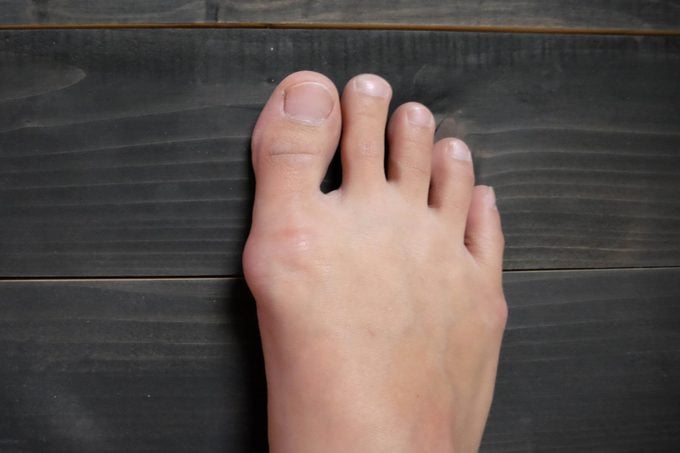7 Ways to Treat Bunions (Without Surgery)
Updated: Nov. 10, 2022
Bunions worsen over time, so intervening early is key. These non-surgical treatments are a great place to start.

There are some health problems that you don’t expect to experience until your golden years—or preferably, never—and bunions is one of them. But bunions can actually appear at any age.
A bunion is a deformity of the foot. “It’s a biomechanical imbalance of the foot, where the first metatarsal bone is shifting out of alignment,” says podiatrist Miguel Cunha, DPM, founder of Gotham Footcare in New York City. The metatarsal bones are the long bones of the feet, and the first metatarsal is the one located behind the big toe. It’s a misconception that a bunion is a bony growth on the inside of your foot—it only appears that way, Dr. Cunha says. What you’re really seeing is the shifting of this bone.
How common are bunions?
Though the risk of developing bunions increases with age, research estimates that nearly one in four people between the ages of 18 to 65 have a bunion. For those over age 65, more than one in three people have them. Part of it is due to genetics (thank your parents or grandparents), but women are more likely to get them from years of wearing heels. “These shoes push your big toe over to the outside of your foot, creating an imbalance that makes the metatarsal bone shift inward,” says Dr. Cunha.
How do I know if I have a bunion?
If you compare your feet to someone else’s at the beach or pool, you’ll see a pronounced bump on the inside of your foot at the big toe joint, says Dr. Cunha. Symptoms include pain and tenderness, redness and inflammation, a callous on the bump (from rubbing against your shoe), or stiffness in the joint, according to the American Academy of Orthopaedic Surgeons.
Intervening early is key. “Bunions progressively worsen over time,” says Dr. Cunha. Treatments depend on your level of pain. He recommends rating yours on a scale of 1 to 10, with 10 being severe pain. If yours is less than a five or six and you want to know how to get rid of bunions, then trying conservative, non-surgical treatment is a great place to start.
Avoiding surgery when you have bunions
“Conservative treatment is directed at addressing symptoms,” explains Dr. Cunha. “But once the bone shifts out of alignment, there’s nothing you can do to shift it back in other than surgery.” The following fixes can minimize your discomfort, treat any inflammation around the joint, and soothe irritation of the nerve and soft tissue.
Try the following for a few weeks to see if there’s any improvement in symptoms:
Avoid heels. They may have gotten you into this mess in the first place. “Wearing them will not only feel bad in the short term, but it will exacerbate the bunion long-term. They can cause a moderate bunion to turn severe,” says Dr. Cunha. Another thing that will help: Avoid the trend of wearing shows without socks whenever you can.
Be smart when shoe shopping. Try on shoes at the end of the evening, when your feet are at their plumpest. (Your feet progressively swell throughout the day.) This ensures your shoes will be comfortable—not tight—all day. If there’s still a spot that pinches, gel pads or moleskin may provide some relief.
Consider arch support. If you have flat feet, you’re more prone to bunions. In this case, arch inserts (or shoes that specifically offer arch support) can help, says Dr. Cunha. You could also see a podiatrist about a custom orthotic. “Orthotics don’t correct bunions but they assist you so you can walk comfortably, and slow down their progression,” he says.
Try a bunion splint. There are “bunion splints” or “big-toe straighteners” that you can find at the drugstore or on Amazon. But in terms of how to get rid of bunions, they won’t do it alone. “There’s an expectation that these will correct a bunion, but they never do. They shift the bunion more into alignment but this is temporary,” says Dr. Cunha. These splints may enhance the comfort of muscles and soft tissues, but that bunion will reappear as soon as you take them off.
Give your tootsies TLC. Treat sore and red feet with ice, a nice foot massage, and if necessary, by taking ibuprofen to reduce swelling, says Dr. Cunha.
See your doctor. While it’s tempting to try to address this yourself, it’s worth seeing a podiatrist for more effective therapies such as ultrasound or electrical stimulation. “These decrease inflammation around the joint, interrupt the pain cycle, and promote blood flow that helps heal ligaments around the joint that are sprained or fraying because the bone is not in alignment,” says Dr. Cunha. Your doctor may also take an X-ray to track the progression of your bunions. Discover 13 more things your podiatrist wishes you knew about your feet.
When to consider surgery
If, after all these efforts, you’re still experiencing a high level of pain or the bunion compromises your ability to walk, you may need surgery.